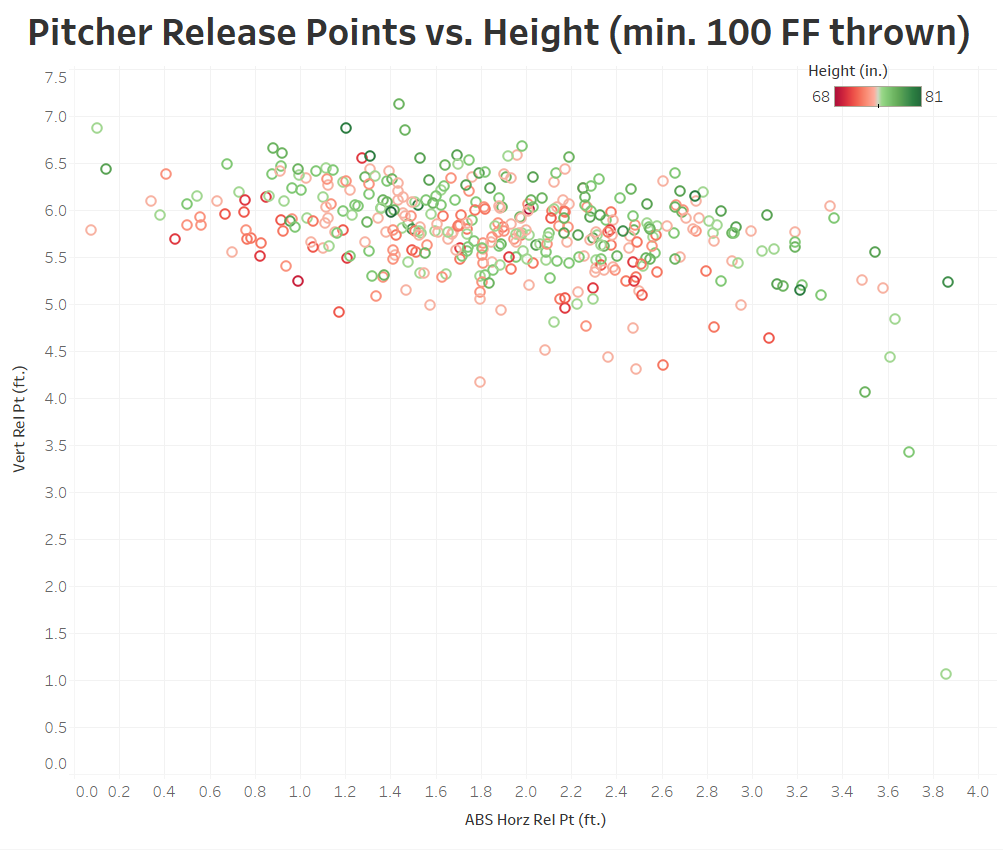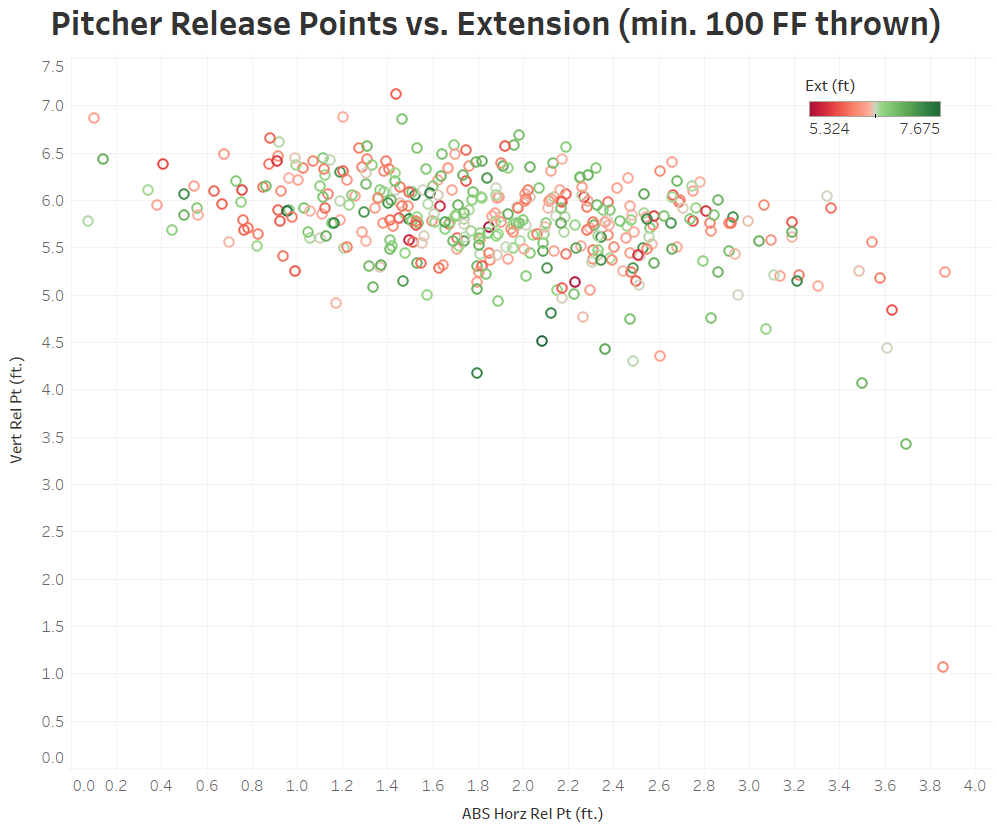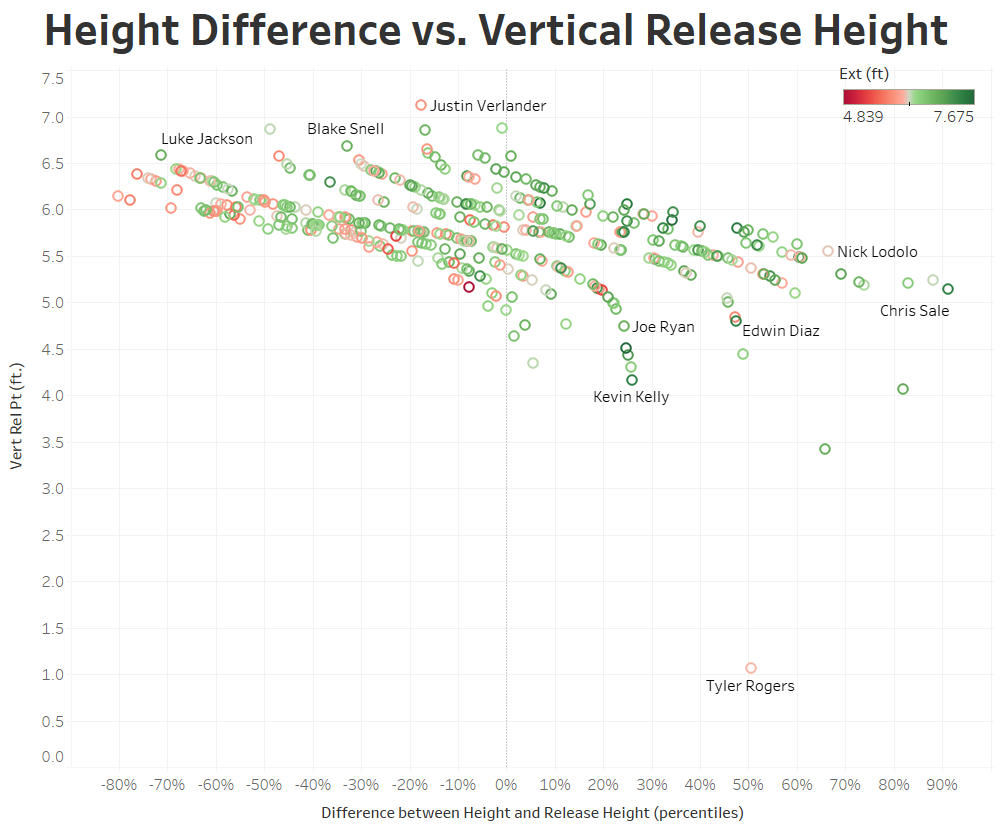Modern-day pitching analysis requires knowledge about various physical factors contributing to pitch characteristics. Aspects like extension, release height, and even where on the mound a pitcher stands all drastically affect how a hitter perceives a pitch. Although many of those are integrated into Stuff models, how a pitch is released via release point is part of some pitchers’ unquantifiable deception on the mound.
The recent discovery of the variation in mound height on Twitter/X by Johnny Nienstedt got me thinking about the differences in pitchers’ heights.
We’ve made good strides at quantifying park factors based on climate/altitude, but there is another unique quality of every park which I’ve not seen analyzed: the mound.
Using release height data, we can roughly estimate the differences in mound height between ballparks: pic.twitter.com/vy0LEBj1Vt
— Johnny Nienstedt (@JohnnyNienstedt) August 20, 2024
We hear about height more in scouting reports early on in a player’s career because they’ve presumably figured out how to succeed by the time they make it to MLB. Looking at leaderboards for pitch characteristics yields release point information and extension, which makes it possible to reasonably predict a pitcher’s height, but it doesn’t fully grasp it. Here are the release points and height of the 404 players with at least 100 fastballs.

Unsurprisingly, taller pitchers have generally higher releases on average, but there is significant variance in the 1.4 ft. to 2.4 ft. range for the absolute value of horizontal release points. Now, mixing that with extension, there are some differences.

The color scale changes slightly since shorter pitchers are not able to get as much extension., but it’s not a 1:1 conversion between the two since much of the art of pitching is unique mechanics.
Why height matters, in an extreme case, can be exemplified by Bailey Ober. Ober stands 6’9″, making him one of the tallest pitchers in baseball. His fastball has a 29.6% CSW% (73rd percentile among starters’ fastballs) despite an average velocity of 91.9 mph. He gets exceptional extension at 7.2 ft, making the fastball’s velocity play up as it has a shorter distance to home plate. His extension contributes to deception because Ober’s release height of 5.97 is average.
With that in mind, I wanted to examine players whose heights differ significantly from their release height, so I calculated the difference between them and compared it to their release height.

At the extreme right are those like Sale and Lodolo, who are both 6’6″ but throw from a low three-quarters arm slot and extend horizontally. At the other end of the spectrum are pitchers like Snell and Verlander, who are extremely over the top. The difference between height and release height correlates strongly to where their horizontal release point is.
A few players stand out within this visual, with large differences between heights and intriguing fastball metrics. By focusing on releases that appear unusual, this group is able to see additional success from their fastball.
Scott has one of the bigger gaps between release height and height, with a 56% difference in percentiles. Standing at 6’4″, Scott gets seven feet of extension and propels himself to a 5.24 ft. release height. Scott has a standard three-quarters arm slot too, making his release appear standard outside of his extension. Scott excels at locating fastballs up the zone by having a lower release height and standing at 6’4″.
Despite just average ride on his fastball, he’s able to get whiffs due to the exceptional attack angle he creates. Though the fastball still could improve in getting called strikes, Scott has the framework to miss bats with his primary pitch, a must-need in today’s MLB.
Rodriguez is slightly taller than Scott and has a taller release, but he has some of the best extension in baseball at 7.3 feet. This situation is similar to Scott, where the fastball plays up in the zone due to plus velocity at a great angle.
He gets even more whiffs on the pitch (13.5%), and it also helps that his fastball is almost 2 mph harder. Rodriguez’s height gives him the levers to achieve substantial extension and formulate a strong release point with everything else.
Brown is on the other end, boasting a tall 6.3 ft. release height while standing just 6’2″. He doesn’t get as much extension as the first two, allowing him to stand more upright on release. The real diverting factor is that Brown is significantly more over-the-top in his arm angle, which works in two ways. First, Brown has a much sharper vertical release angle due to his higher release, meaning he has to release the pitch more downward to get it towards the strike zone. Secondly, this arm angle allows Brown to generate more backspin on the ball, propelling it to get more induced vertical break.
Brown gets more whiffs than even Rodriguez on his fastball at a 13.9% whiff rate, which is in the 91st percentile for fastballs. Though accomplished in other ways (and through pitch mix changes), Brown can end up with similar results to the other two despite showing very few similarities.
Last is Luis Castillo, who gets some of the shortest extensions out of any starter in baseball yet still has an effective fastball. At just 5.3 ft., Castillo short-steps the mound as he releases from a low three-quarters arm slot. This creates an unusual low angle/short extension combo, which results in his fastball breaking horizontally more than most.
Castillo’s unusual fastball profile is also used uniquely: he goes upstairs with a horizontally moving pitch. It clearly works, generating a 13.8% whiff rate. Castillo’s low slow prevents him from getting significant ride on the fastball, but he’s able to overpower hitters at 95 mph up in the zone like he’s one of the other pitchers that I talked about.
There’s a reason scouts look for a particular size when drafting/acquiring players: it allows them to achieve release points (along with velocity) that are hard to hit. While that gets forgotten once players are in professional baseball, the actual interaction effects between height and release point are fascinating.
